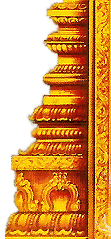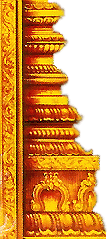| |
|
|
 | Singers: |  |
| |
|
|
| |
- |
|
| |
|
|
 |
Festival: |
 |
| |
|
|
| |
Panguni Uthiram in March-April; monthly Kruthika star days and Tirukarthikai in November-December are the festivals celebrated in the temple. |
|
| |
|
|
 |
Temple's Speciality: |
 |
| |
|
|
| |
A deep foot print considered as that of Lord Muruga is seen on a stone nearby the temple as if pressed on sand. Another rock nearby, looks as if a peacock is holding a snake in its mouth. These are still visible even today. A spring is ever flowing even during hot summer, revered as the sacred spring of the temple. There is also a sand space at a higher level about 75 feet from the temple. This sand is offered as Prasad - sacred ash to the devotees. |
|
| |
|
|
 |
Opening Time: |  |
| | | |
| |
The temple is open from 7.00 a.m. to 5.00 p.m. |
|
| | | |
 |
Address: |  |
| | | |
| |
Sri Balamurugan Temple, Thandikudi, Dindigul |
|
| | | |
 |
Phone: |  |
| | | |
| |
+91- 4542- 266 378, +91- 99626 71467 | |
|
| | |
 |
General Information: |  |
| |
|
|
| |
In olden days, certain incidents among other reasons were instrumental for building temples. Some temples were built by many kings, for example the Madurai Meenakshi temple by Pandyas and the Naickers. Some temples had been built by a single king with all dedication and efforts as that of the Thanjavur Big Temple. Some kings had built many temples- example 75 Shiva temples by Chola king Kochenganan. Besides kings, many Siddhas were responsible for building some temples as that of Palani Murugan Temple by Bogar and Tirupathi Balaji temple by Siddha Konganar. But all such temples were completed only after a long period.
|
|
| |
|
|
 |
Prayers |  |
|
|
| |
| |
Devotees pray in Thandikudi temple for the merciful
blessings of Lord Bala Muruga.
| |
|
|
| |
 |
Thanks giving: |  |
|
|
| |
| |
Devotees carry Kavadis to Lord Muruga during the Panguni Uthiram festival. | |
| |
| |
 |
Greatness Of Temple: |  |
| |
|
|
| |
According to one story, Lord Muruga went to Palani only from Thandikudi. It is therefore believed that Palani darshan would be complete, if the devotee begins his pilgrimage from here. It is also believed that Lord Muruga jumped every step (Thandi Kudhithal in Tamil). His Holiness Sri Pandrimalai Swamigal (originally Ramaswami by name) brought Lord back to Thandikudi as Balamuruga.
Substantiating this incident, a great light appeared in Thandikudi (the name is derived from the jumping journey of Lord Muruga from this place to Palani and back) hills for three days continuously. People went to that Jyoti spot and found the foot prints of Lord Muruga indicating His coming back.
Nearby, a rock appears as a peacock (Lord Muruga’s vahan) holding a snake. A perennial spring on a rock is the sacred theertha of the temple. The sand at a nearby place is offered as the sacred ash Prasad to the devotees.
|
|
| |
|
|
 |
Temple History: |  |
| |
|
|
| |
After staying for a while in His 6th Padai Veedu – army camp – in Pazhamudhir Solai, a place of hilly environment, Lord Muruga came to Thandikudi. It is during this time, Idumban, disciple of Sage Agasthya brought two hills – Shivagiri and Shakthigiri – to Palani hills. Lord Muruga chose one for him and reached the hill jumping. Thus the place was named as Thandikudhi which later changed as Thandikudi.
As prayed by His Holiness Pandrimalai Swamigal, Lord Muruga directly appeared in the dreams of devotees and arranged supply of necessary materials for building the temple here including the idol of the presiding deity through a sculptor. It is also believed that the construction of the temple was directly supervised by Lord Muruga Himself. The temple has shrines for Navagrahas the nine planets, Sage Agasthya Lord Vinayaka and Lord Muruga, Lord Bhairava. Peacock and Idumban shrines are also in the temple. The consecration of the temple took place grandly in 1949. Marudanayagam and Ganapathy are presently the head priests of the temple.
|
|
| |
|
|
 |
Special Features: |  |
| |
|
|
| |
Miracle Based:
A deep foot print considered as that of Lord Muruga is seen on a stone nearby the temple as if pressed on sand. Another rock nearby, looks as if a peacock is holding a snake in its mouth. These are still visible even today. A spring is ever flowing even during hot summer, revered as the sacred spring of the temple. There is also a sand space at a higher level about 75 feet from the temple. This sand is offered as Prasad - sacred ash to the devotees.
|
|
| |
|
|
|
| |
|
|





